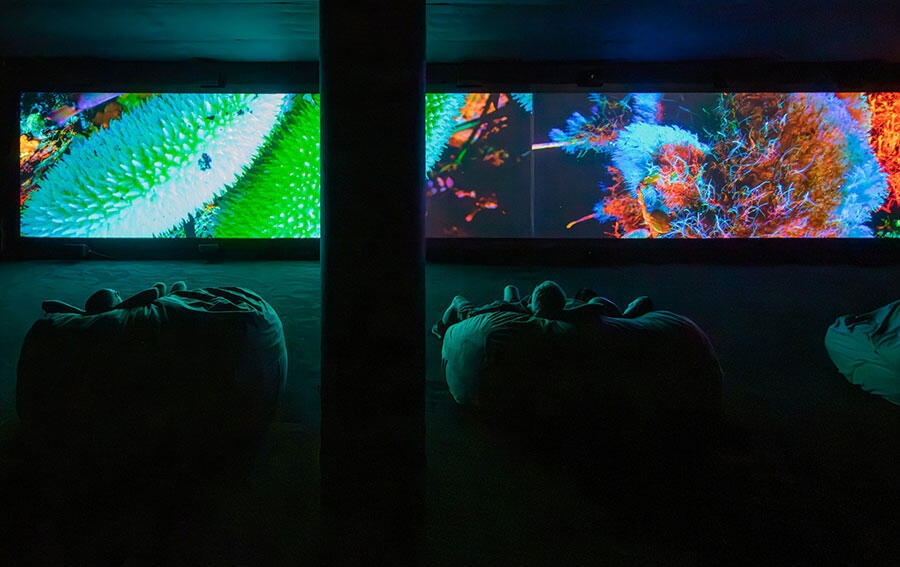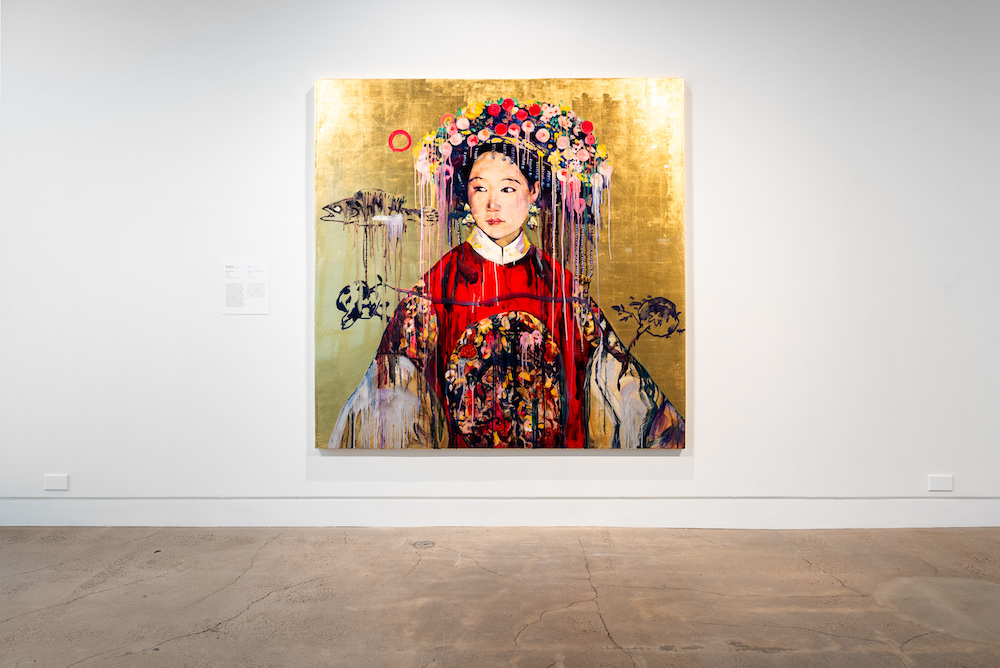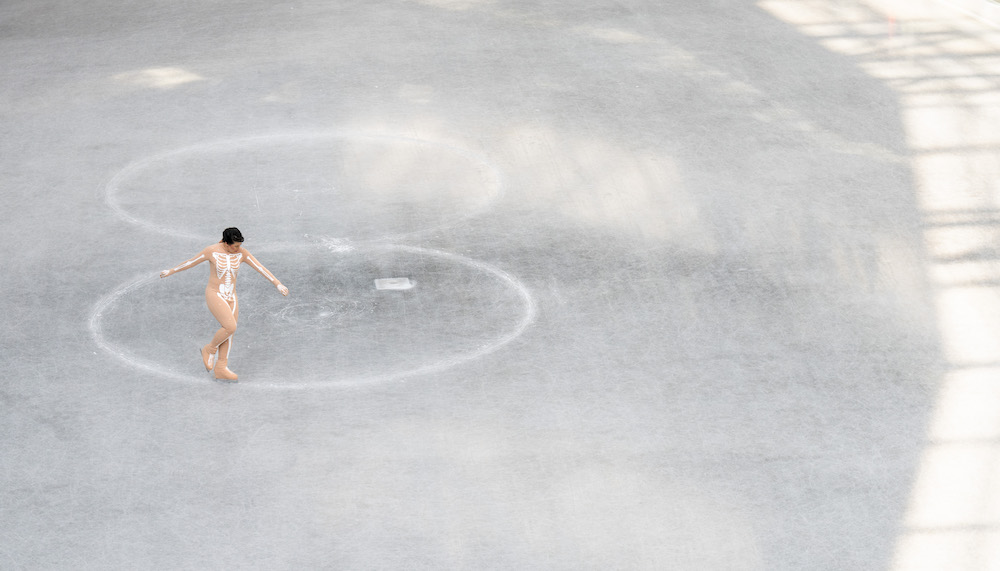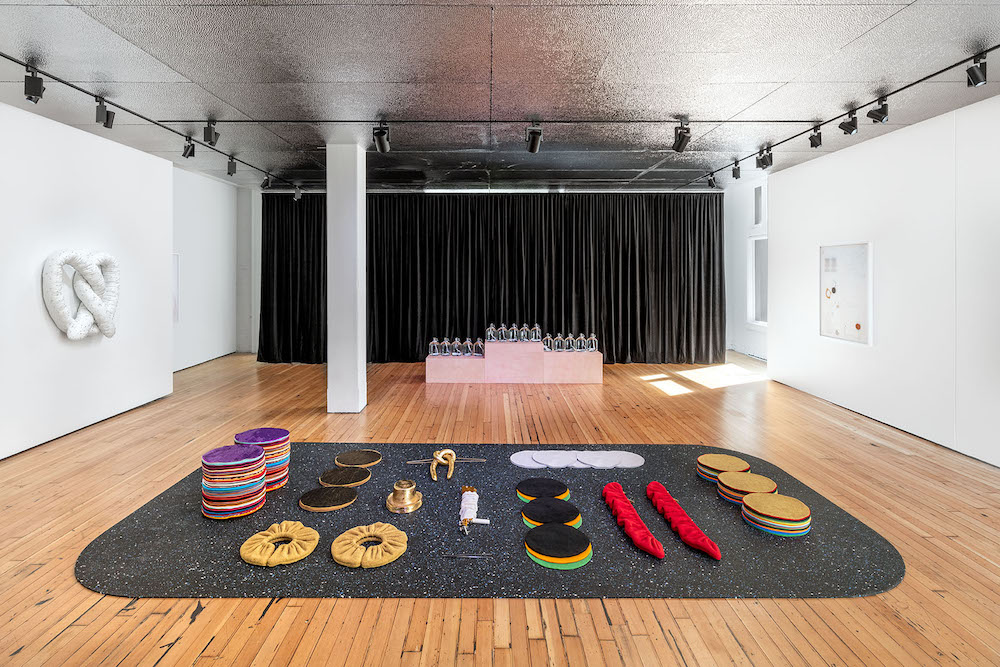The Converge 45 biennial initiative exists to forge a regional, national, and international artistic discourse, and to intentionally center certain aspects of those conversations within the Pacific Northwest arts ecosystem. Showcasing some 50 local, national, and international artists at 15 official venues and dozens more locations, projects, and group shows, the idea is that the art world should make a point of coming to Portland—but the deeper idea is that the world is already there.
The 2023 edition has been guest-curated by renowned critic Christian Viveros-Fauné, an art historical-minded writer and adventurous curator with a penchant for the politically salient in visual culture. Under the rubric Viveros-Fauné’s book Social Forms: Art as Global Citizenship, the biennial proceeds outward like the spokes of a wheel from its core—a substantial group exhibition that deals directly and poetically with the dynamics that shape contemporary political art in personal and global contexts.
A further suite of official satellite exhibitions aligned with the vision partnered with Converge 45 to produce integral shows at area galleries, museums, college campuses, nonprofits, and famous gardens; plus, a broader range of affiliated pop-ups, bookshops, design studios, and more signed on—all pulling together to increase the visibility, curatorial scope, and diversity of contributions to the discourse by local stakeholders. Being spread out across Portland, the treasure map aspect of the experience also offers a great way to see the city.
Centered in the rapidly hipster-fying but historic, beautiful, bustling, and walkable Pearl District—where the city’s highest concentration of galleries and art centers can be found—the foundational three-part core show “Assembly” filled three locations: the nonprofits Parallax Art Center and Stelo Arts, and the galleries at the Pacific Northwest College of Art (PNCA). Work included ranged from narrative and autobiographically-grounded mixed media paintings by Narsiso Martinez, merging humble materials with gorgeously rendered portraiture and art historical signifiers in a Courbet-like bid to tell history from an underrepresented socioeconomic point of view; to Judith Wyss’ intimate, lovingly crafted dioramas of shabby but lived-in architectures that speak to the potential for the poetry of everyday day life to flourish anywhere; to Vo Vo’s regal yet folksy, comfortable yet unattainable woven textiles that contain slogans of exhaustion and resistance; and to Sara Siestreem (Hanis Coos) who elicits contemporary sentiments from the language of traditional, ancestral, ceremonial materials and idiomatic, medicinal crafts.
Throughout the scope of gathered works, across monumental and ephemeral, abstract and Pop-inflected, and assertively analog voices, Assembly set a tone for the fuller biennial, of shying away from neither beauty nor confrontation, and of reaching for something more than headlines, selfies, and palliative progressive gestures—opting instead for the kind of spark in soul and psyche that could prompt real action.

Richard Mosse, Broken Spectre, installation view, Lewis & Clark College, 2018-2022. Photo: Mario Gallucci. Courtesy of the artist and Converge 45.
An affiliated exhibition of photographs by Richard Mosse at Blue Sky depicted the mutual incursions of potted and feral plants in and around domestic and public spaces in Belém do Pará, Brazil. The eerie, recombinant beauty of romantically neglected architecture and botanical striving is both picturesque and provocative, with emotional effects of fecund trepidation amplified by the gorgeous chromatic saturation of his trademark interventions with color infrared and other unconventional film processes. The work’s cheeky suggestion is that civilization is under counterattack from the natural world, which is always on the brink of reclaiming its territory in the places we’ve manicured.
But Mosse’s star turn at Converge 45 comes with the screening of his monumental three-channel, 74-minute film Broken Spectre (2022) in a movie theater at the Hoffman Gallery at Lewis & Clark College. Deploying all of the heightened drama of his cinematographic eye and the aesthetic expression of the scientific photographic processes and color filtrations that have come to define his practice, in this ambitious, towering, durational work, Mosse both evolves and upends previous stages of his vision. His unique style of forcing extreme prettiness (the irresistible fuchsia of trees in a sweeping landscape) and terrible violence (fiery, smoke-clogged biome-murder) into close conversation has been very successful in bringing attention to global troubles. The beauty lets the brain give the eye permission to linger, and thus the artist longer to deliver the underlying message. If the biennial’s studious orientation was toward responsible global citizenship, this film is the crash course.
In the case of this document of the Pyrocene Age, the message—the urgency and abomination of Amazon deforestation—is not as snugly tucked inside the honey of pictorialism. The horror is rather front and center, alternating with lofty, prismatic forest canopy aerials and chromatically saturated up-close details from the burned-out floor, set against the drumbeat of a physically immersive audio visual manifesto across three movie theater-size screens. It’s rarely pretty (it is sometimes) but it is always cinematic, and in that way it competes with disaster-themed entertainment in its impactful presence. Devastating, not delightful, but still, the viewer cannot look away—even when we and the artist are directly implicated in the botanical slaughter by an impassioned stakeholder with a true understanding of the disaster porn game. You leave the theater as the artist intends—flickering on the precipice of despair and determination, in awe of the beauty of the world, and incapable of disengaging from the issue at hand.
At Pacific Northwest College of Art alongside another third of Assembly, an affiliated satellite exhibition by L.A.-based, Portland-identifying photographer and occasional sculptor Rodrigo Valenzuela offered photography-based works that were as quiet and mysterious as Mosse’s were operatic. The black and white images in “Garabatos” distill and reformulate abstractions of the obscene gestures people make when they’re insulting each other. Photographs of sculptural objects Valenzuela produced in the studio for the purpose, white on white like minimalism or jumbled bones, are personal in scale but societal in scope. Based on a specific circumstance that arose during an authoritarian era in Latin America, Valenzuela examines that historical period of resistance through a rarefied philosophical and philological lens, with the smattering of dark humor the idiom deserves. Beyond regional vernaculars, Valenzuela wonders how we can encapsulate the essence of such moments of collective yet individual spontaneous resistance in more abstract and therefore universal visual languages—almost a De Stijl approach to flipping off the oppressors.
Marie Watt’s “Chords to Other Chords (Relative)” at the Center for Native Arts and Cultures generated a compelling alternative kind of monument. Part land acknowledgment, part send-up of the kind of (probably) well-intentioned but (almost certainly) hollow gesture, part atmosphere-activating light-based sculpture, part satire and part genuinely felt honorific, the work created a gathering place and a topic of conversation with the power of its accessible, multi-sensory messaging object.

Hung Liu, “A Question of Hu: The Narrative Art of Hung Liu, From the Collections of Jordan D. Schnitzer and his Family Foundation, installation view, Jordan Schnitzer Museum of Art at Portland State University, 2023. Photo: Deann Orr. Courtesy of the Jordan Schnitzer Family Foundation.
The Jordan Schnitzer Museum of Art at Portland State University’s expansive exhibition “A Question of Hu: The Narrative Art of Hung Liu” draws from the collection of the Schnitzer Family Foundation, and is likewise curated by Viveros-Fauné to help anchor the biennial in the art historical context of her extraordinary career and the even more extraordinary life story that forms its basis. A selection of large-scale, richly worked, textured, layered, detailed, and complexified portrait- and landscape-based mixed media paintings, along with elements of assemblage and woven textile, distill Hung Liu’s passion to understand the dynamics of geopolitical unrest, immigration, racialized historical narratives, class struggles, and personal identity—a seriously on the nose point of view and a proper touchstone for the Converge 45 project.
At the well-appointed HQ of the Jordan D. Schnitzer and His Family Foundation Collections—a hybrid storage, registerial, and roomy exhibition space—the group show “We Are The Revolution” further draws on the Foundation’s holdings in an intentionally diverse (in both maker and medium) group show curated in direct dialog with the issues under consideration—specifically asking the question, Exactly who and what made America? It’s a sprawling, almost overwhelming exhibition on a museological scale (and in fact like all the foundation’s curated exhibitions, it’s ready-to-go as a traveling property). The show features masterpieces by Kehinde Wiley, Hank Willis Thomas (an intimate smaller-scale version of his MLK monument reads quite differently as a gleaming interior work), Robert Colescott (an artist the family has long supported), Kara Walker (whose stunning exhibition of prints and multiples from the collection is currently on view in Los Angeles), Titus Kaphar, Dinh Q. Le, Roger Shimomura, Swoon, Derrick Adams, Joseph Beuys, a monumental vanessa german, a moody near-abstraction by Alison Saar, loads of sumptuous Mickalene Thomas portraits, salient text-based works from Jenny Holzer and an Andy Warhol electric chair.
From the mountaintop view to the intimate deep-dive, but no less engaged with various kinds of contested histories and their intersections with capital, social constructs, and personal memory, comes the Portland Pearl District gallery ILY2 (I Love You Too) with an independent but interrelated solo exhibition and extremely site-specific performance by Los Angeles artist Amanda Ross-Ho. Ross-Ho used to be a figure skater, and a pretty dedicated one at that, in competitions and everything. Think sequined flesh-toned body stockings and all the hairspray the law allows. Think about a young woman becoming increasingly unconvinced by that lifestyle and all that it entails and implies, ending up at art school, and decades later returning to the subject via the sculptural mediums she now favors. And because it’s Portland, also think about Tonya Harding.

Amanda Ross-Ho, Untitled Figure (the center of it all), performance view, Lloyd Center, Portland, 2023. Photo: Simone Fischer. Courtesy of the artist and ILY2, Portland.
As a personal exercise in memory, Ross-Ho filled the gallery with soft-sculptures, found objects, and personal possessions both embodying and interpreting the precise equipment, aesthetic appeal, and choreographed energies involved in professionalized skating. Hard steel blades, soft custom slipcovers, rhinestones and soft mats, lycra, zippers and vintage Capezio. Around a secret nook, the performance costume of her youth was laid out in a body bag. Metaphor abounds, for gender roles and commercial spectacle, for dreams achieved and dashed, for memory and childhood, for the exertions of the body and the body as it changes. Nearby sits Portland’s famous Lloyd Center Ice Rink—a public rink, very much still in use, located inside a derelict but rather iconic shopping mall with a Crystal Palace-worthy atrium and a snow machine—best known as the place Harding was forced to practice for lack of funds to score time at the fancy sports center.
It was there that Ross-Ho staged a one-time performance in which she donned her old costume and performed a routine. As of that morning, she had not taken the ice in years, and aside from the emotion and nostalgia of the “reenactment” scheme, this made the real subject of the piece the question of whether she still knew how. Relying on muscle memory as much as biographical memory, she was just as curious to see how it would go as anyone. A secondary but salient effect of the piece was to prompt about 65 fancy international art-world people to gather, breathless, and watch a skating show in a somewhat derelict mall a few miles from downtown—to be forced by heartfelt emotion out of their erudite, analytical stances and into the kitsch and crafted presence of the experience. It was brilliant.
Next door to ILY2, back across the river in the comfortable art world setting, another gallery exhibition played with play. Peter Gronquist’s “Manifest” at Elizabeth Leach Gallery presented a suite of exceptionally materialist yet paradoxically ethereal mixed media paintings on armatures of assemblage. Molded polyurethane, dyed wasp paper, textiles, rose quartz, ash, metal, fossilized live music show posters chiseled from telephone poles…all of this is prepared ground for delicate painting in blushing eggshell tones, whose layers seem pierced by the embedded “objects,” or perhaps whose layers constitute the fig from which they emerge. As abstract and mysterious as they are, Gronquist nevertheless wrings a sense of place from them, or rather a lingering sense of a place which may or may not still exist. But the enormous, noisy, possibly dangerous contraption he built for the entrance—a steel construction that drags small boulders the size of large boulders across the floor on heavy chains whenever the viewer hits the right button, evoking classic Martin Kersels and creating a “drawing” on sheet metal with its percussive trail—soon righted everything back into a more subversive state of presence.
Gronquist also presented SKY LINE—a vivacious abstract neon gesture atop an industrial freeway-facing facade, unveiled with a catered parking lot party and night viewing that was honestly the most Portland thing that ever happened. There were kids and cocktails and plastic chairs on gravel fields, there was even a neighborhood tutu bike parade for atmosphere, and it seemed somehow perfect to end the trip as it began—exploring the hearts and edges of a time and place and what it means to live in this world; off the beaten path in some ways, and right at the center of it all in others.
In 2018 Zwirner Books published Social Forms, a compendium of 50 essays by Viveros-Fauné on the expanded field of political art. In it he considers artists from Goya to Guston, Holzer to Hammons, Picasso to Pussy Riot, and describes his early, formative, and indelible realization that, “There is no greater work of art than that which critically engages one’s own time.” And, that is a perfect encapsulation of his overall curatorial vision for this edition of Converge 45—titled “Social Forms: Art as Global Citizenship,” the biennial all about how art can and, should be, a force to shape history, and not merely its witness.
Exhibitions open and close on a rolling basis through October, with many continuing through the end of the year. Free and open to the public, except the regular general admission ticket required at Portland Japanese Garden, to see Bosco Sodi’s video installation there. converge45.org.



















Its incredible that in all articles
Related to the biennial anybody mention the work that i made for it and one of the most politicals
Ones, may be if for that because talks about war, that now supposed to resound more because palestine war